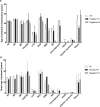Genetic characteristics and epidemiology of inherited retinal degeneration in Taiwan
- PMID: 33608557
- PMCID: PMC7896090
- DOI: 10.1038/s41525-021-00180-1
Genetic characteristics and epidemiology of inherited retinal degeneration in Taiwan
Abstract
Inherited retinal degenerations (IRDs) are a group of phenotypically and genotypically heterogeneous disorders with substantial socioeconomic impact. In this cohort study, we tried to address the genetic characteristics and epidemiology of IRDs in Taiwan. Totally, 312 families with IRDs were identified and recruited and genetic testing was performed via probe capture-based NGS targeting 212 IRD-related genes. Statistical analysis was based on the proband of each affected family. Disease-causing genotypes were identified in 178 families (57.1%). ABCA4 variants were the most common cause of disease in this cohort (27 families, 15.2%), whereas CYP4V2 variants were the most common cause for the single phenotype-Bietti's crystalline dystrophy (12 families, 3.8%). Some variants such as ABCA4:c.1804C>T, CYP4V2:c.802-8_810delinsGC, and EYS:c6416G>A were population-specific disease-causing hotspots. Probands affected by ABCA4, RPGR, RP1L1, and CEP290 sought medical help earlier while patients affected by EYS and CYP4V2 visited our clinic at an older age. To evaluate the representativeness of our cohort in the genetic epidemiology of IRDs in Taiwan, our demographic data were compared with that of the total IRD population in Taiwan, obtained from the National Health Insurance Research Database. This is currently the largest-scale, comprehensive study investigating the genetic characteristics and epidemiology of IRD in Taiwan. These data could help patients and caregivers to adopt precision genomic medicine and novel gene therapies in near future.
Conflict of interest statement
The authors declare no competing interests.
Figures





References
Grants and funding
LinkOut - more resources
Full Text Sources
Other Literature Sources

